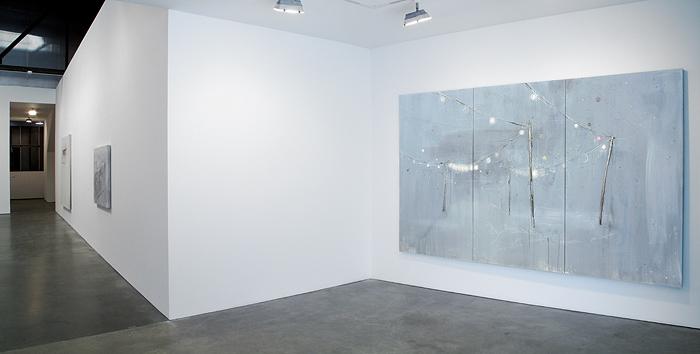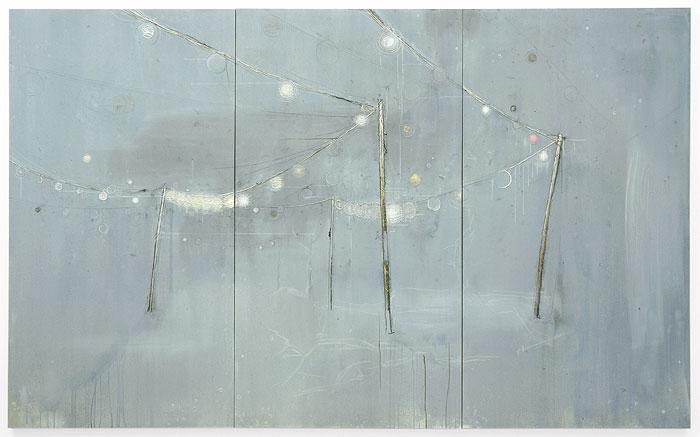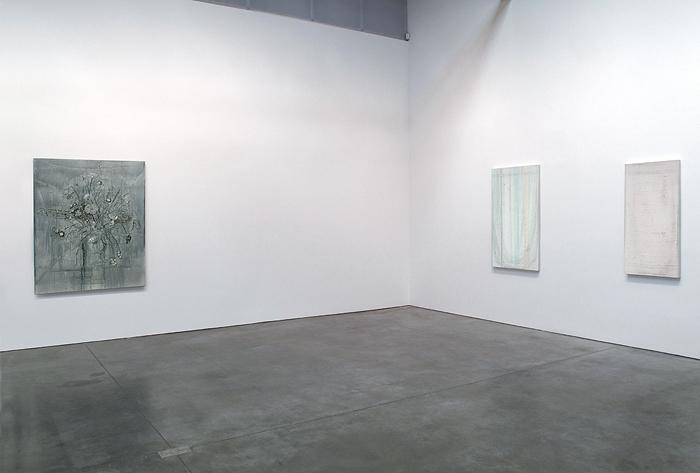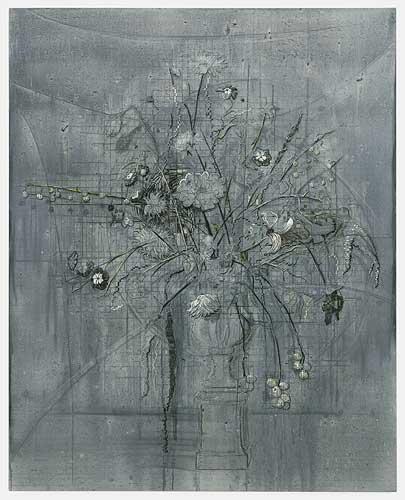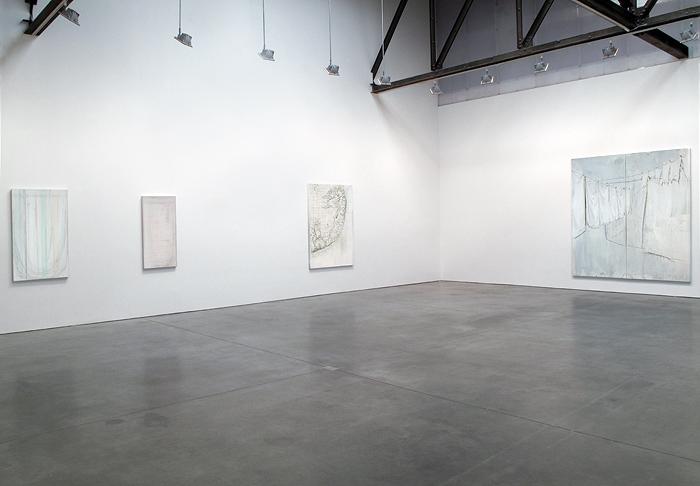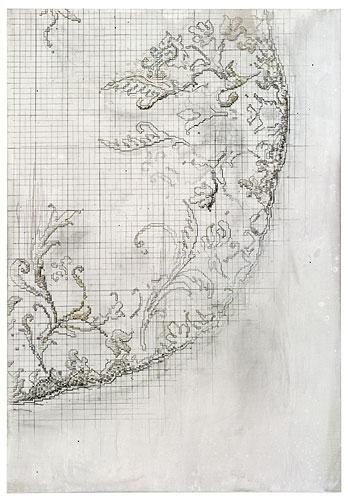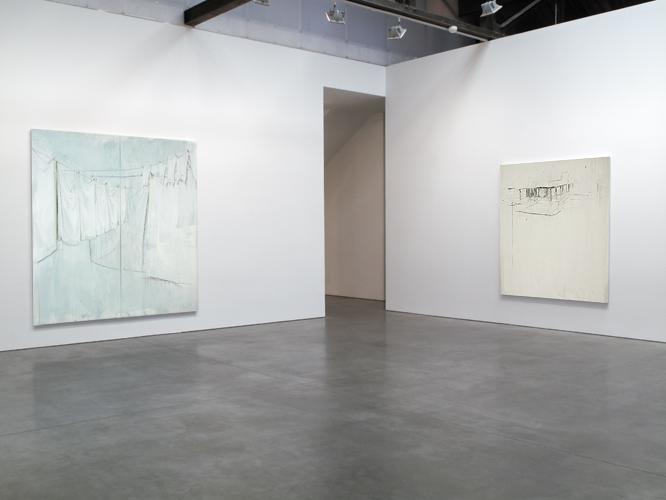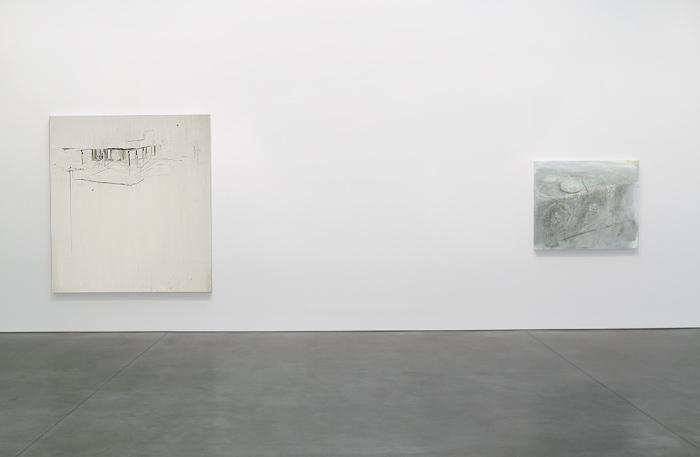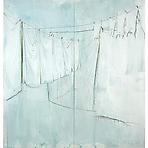Michael Raedecker
fix
March 14 – April 18, 2009
Main Gallery
Andrea Rosen Gallery is proud to present new work by Michael Raedecker (b. 1963 in Amsterdam, lives and works in London) in his third solo exhibition at the gallery. In his characteristic combination of painting and stitching, Michael Raedecker creates figurative paintings incorporating all of the classic genres of painting. He precedes each of his works with a request for permission. Why this motif? What have other artists done with this theme? What is the current relevance of the genre? Raedecker's inquiring approach to painting and the history of painting has led in this exhibition to a number of intriguing speculations about the shelf life of pictorial genres.
Raedecker's landscapes, as unreal as a set in a television series, are well known. Here, the genre of the landscape is far removed from nature and infiltrated by the make-believe world of film and television.
His still lifes refer back to the Dutch painting of the Golden Age. Details in a damask tablecloth in a still life of two plates and a knife occupy all of our attention. In seventeenth-century "still lifes of display," the damask cloth introduced unity into a fragmentary depiction of displayed foodstuffs and objects. Here, in contrast, the damask creates a dispersion of the gaze, shifting our focus to the material nature of the painting. A painting of a wedding cake serves as a reminder of the pronkstilleven, or "still life of ostentation," as the epitome of good taste, wealth and sophistication. However, the sickly green makes it appear as though the rot has already set in. In Raedecker's work, admonitions about the irreversible nature of decay in the tradition of the vanitas still life appear to become applicable to the genre itself.
A recent flower piece shows how Raedecker's reflection on genres of painting combines with an analysis of non-painted forms of image creation, such as appliqué and digital photography. The picture is from a needlework pattern, while some of the details of twigs and leaves consist of embroidered patches of color that resemble magnified pixels. The pistachio green gives the painting an unnatural, metallic appearance - like an X-ray image of a genre that has fallen into disuse.
The new paintings are subdued. The acrylic paint is often thin and applied in one go, so most of the drawing beneath is still visible. Raedecker uses threads or oil stick to accentuate some of the lines. The viewer can only see the colors from nearby. As in all of Raedecker's paintings, close inspection reveals a surprisingly different picture than a view from a distance. His monumental paintings of washing lines and the abandoned site of a party are remarkable works. We can understand the white sheets as a metaphor for the empty canvas, the "zero degree" of painting. A similar vacuum characterizes the empty party site, where the dim illumination of the lights dissolves into the gray glow of early morning. Feelings of inertia and detachment dominate in many of Raedecker's paintings.
The painting and the subject of the painting coincide almost seamlessly in Raedecker's paintings of bath towels. Soft shadows reinforce the trompe l'œil effect, while the loops on the surface of the paintings make us want to scratch them. If abstraction is a pictorial genre, then the bath-towel paintings, with their striped designs, show respect for the decorative qualities of the abstract painting of the 1950s.
Raedecker's sense of questioning is open, relaxed, and serious, but not without irony and a suspicion of pre-packaged answers. This allows him to reinvent old pictorial categories by giving them new content and meaning.
- Dominic van den Boogerd
This May the Camden Arts Centre, London, will devote their entire museum to a solo exhibition of Raedecker's work. The exhibition will travel to the Gemeentemuseum den Hague, The Netherlands; and the Carré d'art, Musée d'art contemporain, Nimes, France; and will be accompanied by a major catalogue. In addition to other solo museum exhibitions, Raedecker has been included in numerous prestigious group exhibitions, including the 2004 Sydney Biennial, and was nominated for the Turner Prize in 2000.
For additional information and images, please contact Jeremy Lawson: j.lawson@rosengallery.com
